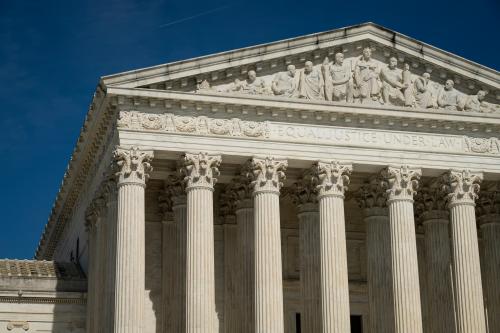By the end of his presidency, President Biden—might—outrank all but one president in the number of lower-court judicial appointments over four years.
Supreme Court appointments get the attention, but circuit and district judges do the heavy lifting. And quantitative studies of thousands of their judicial decisions show variations in outcomes—for civil rights claims, for example, or against environmental regulations—based on party-of-appointing president. Aggregate analysis (at 187) of the decisions of district judges show that the Trump cohort’s decisions are more conservative than those of any president, Republican or Democrat, since Lyndon Johnson in civil rights and civil liberties cases and in labor and economic regulation cases. The Trump judges were more supportive of criminal defendants than appointees of other Republican presidents, perhaps reflecting Trump’s suspicions of law enforcement.
Thus, it matters not only whom presidents appoint, but how many. Table 1 shows the number and percent that presidents’ appointees constitute of all active-status (full-time) federal circuit and district judges, as of late July, 2024. Democratic appointees are a majority of the 643 active-status district judges and of the 821 judges overall. Republican appointees have a very slight edge among the 178 active-status circuit judges (compared to a 96 Republican-80 Democratic appointee breakdown among the 176 circuit judges when Biden took office).
Where does Biden stand and what are his four-year prospects?
A July 8 confirmation marked Biden’s 43rd court of appeals appointee—more, as Table 2 shows, than the full four-year total of all predecessors except Donald Trump and Jimmy Carter. A Senate Judiciary Committee vote later in that week, however, rejecting a district court nominee, with a Democratic senator joining all Republicans, hints at the challenge of matching Trump’s total appointment numbers.
Biden’s combined total of 201 district and circuit judges at this mid-July point is basically even with George W. Bush’s four-year total (203) and second only to Trump’s and Carter’s. The contest for second-most appointments over four years is thus between Biden and Trump. (Carter’s number, boosted by Congress’s 1978 creation of 141 new judgeships, is beyond reach for now.)
Table 3 shows the number of confirmations that occurred between mid-July 2020 and the end of Trump’s four years and the number that will be necessary for Biden to match those figures. Biden needs 11 more circuit confirmations to match Trump’s 54, and 19 more district confirmations to match Trump’s 177. Irrespective of court type, some combination of 30 more Biden appointees would match Trump’s 231.
My assessment from January holds: “[I]t appears likely that the [Biden]administration can’t match Trump’s circuit confirmation numbers but might match his district numbers.” Depending on those district numbers, his overall appointments might match or top Trump’s. To do so, Biden needs fewer confirmations in July-December than Trump got in July-December 2020, but he faces stiffer headwinds than did Trump.
Courts of appeals
Trump had no circuit vacancies to fill from June 2020 to late October, when the first of three vacancies occurred; he filled one of them in December—the successor to Circuit Judge Amy Barrett upon her late October elevation to the Supreme Court.
The 11 circuit confirmations that Biden needs starts with the six pending nominations and a future nominee in advance of a vacancy that will open January 15, 2025; the incumbent (a Republican appointee occupying a Delaware seat) announced his plans in May.
Of the six pending nominations, however, one appears unsalvageable, and several others have encountered stiff opposition from Republican senators, including home state senators. Confirmation of all seven seems highly unlikely. The Senate is split evenly (or 51-50 when Vice President Harris can break a tie), but Democratic turned-Independent Senator Manchin now refuses to vote for nominees who have no Republican support (33 of the 43 confirmations so far received 40 or more “nay” votes); and now-convicted Democratic Senator Menendez, who had been attending his criminal trial, may resign, leaving a vacancy until the Democratic New Jersey governor appoints an interim replacement. And the tie-breaking vice-presidential vote may be elusive as she is out of Washington campaigning for the presidency.
But even were Biden to fill all seven vacancies, he would still need four more vacancies to materialize, and soon enough to allow time for nominations and confirmations. Active-status judges usually retire and thus create vacancies when they become eligible to leave while retaining their judicial salaries. Today (apart from the already announced future vacancies reflected in Table 4), 12 active status Democratic (and 27 Republican) circuit appointees are eligible to leave on salary, but none has publicly announced an intention to do so.
Barring something unforeseen—the resurrection of the apparently unconfirmable nomination, unexpected retirements, deaths, or resignations (leaving before eligible for continued salary), and perhaps reduced opposition to confirmations in a lame-duck session—Biden at most can hope to finish four years with somethings between 43 and 49 court of appeals appointments.
District courts and overall count
Biden needs 19 more district appointments to match Trump’s 177 district judge total. Table 5 shows potential appointments.
But to match Trump’s total appointments of 231 regardless of court level, Biden will need more than 19 district judge appointments, given the near impossibility of Biden’s matching Trump’s 54 circuit judges. Assume three circuit confirmations for purpose of analysis: he would need 27 district appointments to match Trump’s 231 total ([43+3] + [158 + 27] = 231.)
It might seem, on first impression, that if the Senate could confirm 33 Trump district nominees from mid-July, 2020, to the end of the year, it should be able to confirm 27 Biden nominees in the same time frame. The Senate has been confirming nominees fairly quickly—141 median days from nomination to confirmation for Biden’s district judges (versus 233 for Trump’s). It confirmed 32 so far in 2024 (in 97 median days)—a six-month high (although none since May 22).
The Democratic majority, though, faces more daunting challenges than did the Republican majority in 2020:
- Republicans had a 53-47 Senate majority. Today, as explained above, the Democrat-independent 51-50 majority is a near-illusion, given the potential loss of Manchin and possible (temporary) New Jersey vacancy. Also, at last three and possibly five, Democrats face tough reelection bids that could make their votes for controversial nominee problematic. During the tussle referenced earlier that led to the July 11 rejection of a Biden district nominee, a Republican Judiciary Committee member made clear his intention to highlight (at 10:03) the votes of those vulnerable senators in upcoming confirmation battles. Controversial nominees include two who have been waiting for over, or for almost, 300 days since nomination. Republicans claim that one (a Muslim as is the controversial circuit nominee) is a radical; they say the other has extreme views on criminal justice.
- Trump’s nominees benefitted not only from a stronger Senate majority but also relatively modest Democratic opposition—median “nay” votes of 18. Republicans have been more united in opposing Biden’s district nominees—median nay votes of 43, leaving the majority less room for Democratic absences or defections.
- Of Trump’s 33 confirmations, 22 were nominees in states with at least one Democratic senator, who likely had signed off on the nominees under the prevailing “blue-slip” practice, thus making them palatable to other Democrats. By contrast, of Biden’s 26 pending nominees, only four are in states with a Republican senator.
- Trump entered 2020’s final six months with 45 pending nominations. Biden starts with 26, a number one shy of the 27 confirmations he needs under the working scenario, and not all 26 are sure-bet confirmations. Thirty of today’s 39 nominee-less vacancies are in states with a Republican senator (with over 500 median days since vacancy announcement). The administration will probably need to exhaust the vacancies in blue states and seek some red-state nominees whom home-state senators won’t veto under the prevailing “blue-slip” arrangements.
Finally, will Republicans honor the lame-duck confirmation precedent they set in 2020? The 2020 Senate faced essentially the same shortened schedule in place in 2024—out most of August and all of October through election day. It managed to confirm 33 district judges by breaking a long-standing practice of not confirming presidential election-year nominees after the president’s party lost the election.
Of the 33 post-June 2020 district confirmations, 13 came after the election—7 in November (including Southern District of Florida judge Aileen Cannon, now struggling with the Trump documents case) and six in December. Democrats resisted those nominees but couldn’t defeat them. (The median “no votes” on confirmations before November 2020 were 18, but 41 for the 13 post-election nominees; perhaps surprisingly given what we know now, Democrats went light on Cannon, with only 21 no votes).
If Democrats retain the White House, Republican senators will have no lame-duck basis to resist post-election confirmations. If Democrats lose the White House, will Republicans, with a stronger Senate minority than Democrats had in 2020, honor the 2020 precedent and allow lame-duck confirmation of at least some Biden nominees—confirmations that could push Biden’s total to 30 or more?
After Biden leaves office, there will be plenty of assessments of the totality of his judicial appointments. There’s much more to assess than numbers, but numbers make a difference. Biden’s four-year number of lower court judges will outrank all presidents but Carter—and possibly Trump. Whether he is second or third will depend on how often Senate leadership can assemble majority votes for confirmation in a tightly divided Senate.






Commentary
Can Biden top Trump’s number of judicial appointments?
July 23, 2024